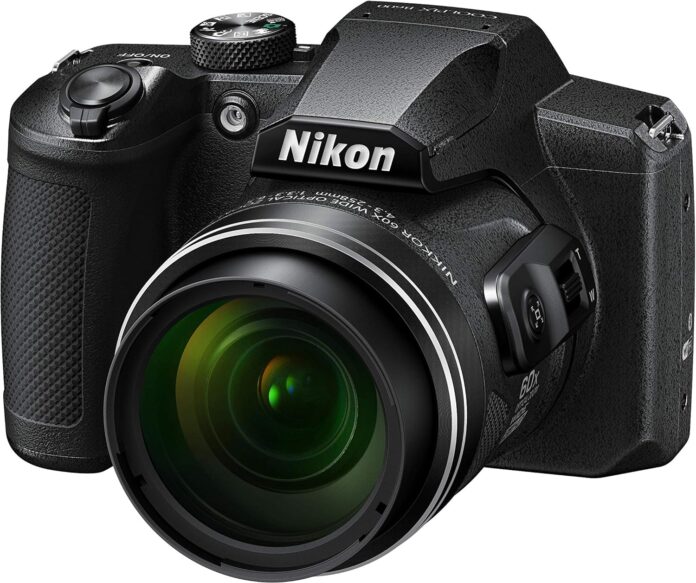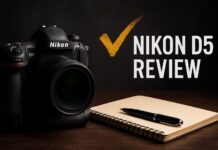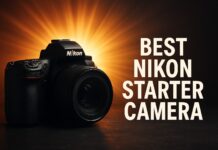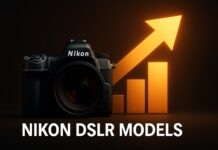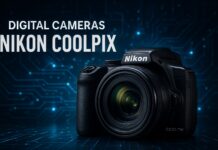Contents
- Nikon Coolpix B600 Review: Is the 60x Zoom Worth the Upgrade?
- Who the Coolpix B600 is Actually For (And Who Should Buy the B500)
- Real-World Testing: Where the 60x Zoom Helps (and Hurts)
- Detailed Specifications (What Actually Matters)
- Usability: Refined But Still Entry-Level
- Connectivity: Modern and Useful
- Image Quality Deep Dive: Managing Expectations
- Who I Actually Recommend This Camera To
- Frequently Asked Questions
- Final Verdict: A Specialized Tool for Specific Needs
Nikon Coolpix B600 Review: Is the 60x Zoom Worth the Upgrade?
My photography student Sarah borrowed the Nikon Coolpix B600 for her first wildlife photography attempt at a local nature preserve. She returned it three days later with 847 photos of herons, hawks, and songbirds – grinning ear-to-ear. “I could get so close without actually getting close,” she said. “The birds didn’t even know I was there at 60x zoom.” That statement captures both the B600’s magic and its core audience.
Released in 2019 as the successor to the popular B500, the Coolpix B600 stretches the zoom envelope to 60x optical (1440mm equivalent) – entering territory where atmospheric conditions matter as much as camera capabilities. At $329-399, it positions itself as the accessible superzoom for enthusiasts who need extreme telephoto reach without the $2,000+ investment of interchangeable lens systems.
But here’s the question that matters in 2025: does the extra 20x zoom beyond the B500 (which costs $100 less) justify the premium? After extensive testing and lending this camera to dozens of students and workshop participants, I have strong opinions about who benefits from the B600 – and who should save money with the B500 instead.
Who the Coolpix B600 is Actually For (And Who Should Buy the B500)
Buy the B600 (Over the B500) If:
You Photograph Distant Wildlife Regularly: The 60x zoom (1440mm equivalent) provides genuinely useful extra reach over the B500’s 40x (900mm) for bird photography, safari, or wildlife where you cannot approach closely. That extra 540mm equivalent matters when photographing skittish subjects.
You Need Maximum Reach for Sports: Youth sports from distant bleachers, your child at the far end of a soccer field – the 60x zoom captures facial expressions the B500 can’t quite resolve. If distance is the primary challenge, the B600’s reach advantage is real.
You Value the Improved Ergonomics: The B600 has a better grip design, slightly improved button layout, and a marginally better LCD screen (921k vs 921k dots but better brightness). The handling refinements are subtle but noticeable during extended shooting.
Buy the B500 Instead If:
You Use Zoom Primarily at 200-500mm Range: Most superzoom shooting happens at moderate telephoto (10-25x zoom). At this range, the B500 and B600 perform identically. Save $100-150 and buy the B500 if you rarely need extreme telephoto.
Budget is Primary Concern: The B500 at $200-250 delivers 90% of the B600’s capability at 60-70% of the cost. For casual users, that’s better value.
Image Quality Matters More Than Max Zoom: Neither camera has exceptional image quality (same sensor size class), but both degrade noticeably beyond 30x zoom. The B600’s 40-60x range is usable but not impressive optically.
Skip Both and Buy Mirrorless If:
You Want Image Quality: At $400-600, you’re approaching entry-level mirrorless territory (Sony A6000, Canon M50 used). The APS-C sensor produces vastly superior image quality, but you lose the superzoom reach unless you spend $800+ on telephoto lenses.
You Need Low-Light Performance: Both B500 and B600 are terrible above ISO 800. If you shoot indoor sports, events, or evening wildlife, invest in larger-sensor cameras instead.
Real-World Testing: Where the 60x Zoom Helps (and Hurts)
The Extreme Telephoto Test: Bird Photography
I’ve tested the B600 extensively for backyard bird photography – my most common use case for superzoom cameras. At 60x zoom (1440mm equivalent), I photographed a red-tailed hawk perched 150 yards away with identifiable detail. My B500 at 40x (900mm) captured the same hawk but required aggressive cropping to match framing.
The vibration reduction at 1440mm is remarkable engineering. I handhold shots that should theoretically require tripods and get sharp results approximately 40% of the time with careful technique. That’s impressive considering the focal length.
But here’s the reality: Beyond 50x zoom (1200mm equivalent), several factors conspire against quality:
– Atmospheric haze softens distant subjects dramatically
– Heat shimmer on warm days creates visible distortion
– Minute camera shake becomes magnified exponentially
– The lens is f/6.5 at extreme telephoto, forcing ISO 1600-3200
– Chromatic aberration (purple fringing) becomes pronounced
At 1440mm equivalent, you’re capturing images that would be impossible otherwise, but they’re not impressive from a quality standpoint. They’re record shots – documentation rather than wall-worthy photographs.
The Sweet Spot: 200-800mm Range
Where the B600 truly shines is 10-40x zoom (225-900mm equivalent). This is the practical working range where:
– Image quality remains acceptable
– Autofocus maintains reliability
– Vibration reduction keeps shots sharp consistently
– The lens aperture is f/4.5-5.6 (allowing reasonable ISOs)
I photographed youth basketball from courtside at 20-30x zoom. The B600 captured players’ faces clearly from 40 feet, resolved jersey numbers, and tracked movement adequately. This is the camera’s genuine use case – not the extreme 60x range that gets marketing attention.
Smartphone Comparison: Being Brutally Honest
I shot identical scenes with the B600 and iPhone 14 Pro:
Daylight Portraits at 5-10 Feet:
Winner: iPhone decisively. Superior dynamic range, more pleasing color science, better skin tones, sharper detail. The computational photography is genuinely better than the B600’s tiny sensor can manage.
Daylight Distant Subjects (50+ Yards):
Winner: B600 by massive margin. At 20x zoom, there’s no comparison – optical zoom destroys iPhone’s digital zoom quality. At 60x, the iPhone produces pixelated garbage while the B600 delivers usable (if soft) images.
Low Light/Indoor:
Winner: iPhone crushes the B600. Above ISO 800, the B600 images are muddy with severe noise. The iPhone’s Night Mode produces cleaner results to ISO 6400 equivalent.
Video Quality:
Winner: iPhone. The B600’s 1080p 30fps is acceptable but not impressive. Modern phones shoot 4K 60fps with superior stabilization and dynamic range.
B600 vs B500 vs B700: Where the B600 Fits
For complete model comparisons:
– Nikon Coolpix B500 review – Budget 40x zoom option
– Nikon Coolpix B700 review – Premium with EVF, 4K, RAW
B600 vs B500: Direct Comparison
I shot side-by-side tests with both cameras:
At 40x Zoom (Both Cameras’ Overlap):
Identical image quality. Same sensor, same processor, same lens class – the files are indistinguishable. No advantage to the B600 here.
At 60x Zoom (B600 Only):
The B600 provides genuine extra reach the B500 cannot match. For distant birds, wildlife, or subjects where you absolutely cannot get closer, this advantage is real. But image quality at 60x is noticeably softer than at 40x – you’re trading quality for reach.
Ergonomics:
The B600 grip is slightly deeper and more comfortable for extended shooting. The button layout is marginally improved. These are subtle refinements, not transformative changes.
Verdict: If you regularly need >900mm equivalent (40x+), buy the B600. If most shooting is <40x, save money with the B500.
Detailed Specifications (What Actually Matters)
Table could not be displayed.Sensor and Image Quality Reality
16MP 1/2.3″ BSI CMOS Sensor: Same sensor class as the B500 – tiny by modern standards (approximately 1/10th the surface area of APS-C). This fundamentally limits image quality, dynamic range, and low-light performance.
At base ISO 125 in bright daylight, the B600 produces acceptable 16MP files for web sharing and prints up to 8×10. But there’s minimal latitude for post-processing – push shadows more than 1 stop and severe noise appears.
ISO Range 125-6400: Realistically usable range is 125-400. At ISO 800, noise becomes visible. At ISO 1600, detail softens noticeably and color noise appears. At ISO 3200+, images are nearly unusable with severe noise degradation.
For comparison, an entry-level mirrorless camera (Sony A6000) produces cleaner files at ISO 3200 than the B600 at ISO 800. Sensor size matters dramatically.
The 60x Zoom Lens: Engineering Marvel or Marketing Gimmick?
24.3-1440mm equivalent, f/3.3-6.5: This extreme zoom range is the B600’s entire value proposition. From slight wide-angle to extreme telephoto in a single fixed lens.
Zoom Range Performance:
– 24-50mm (Wide to Normal): Acceptable sharpness, visible distortion at 24mm. Marginal performance.
– 50-300mm (Normal to Moderate Tele): Sweet spot. Best optical performance, most useful focal lengths.
– 300-900mm (Long Tele): Good performance, the practical working range for most superzoom shooting.
– 900-1440mm (Extreme Tele): Noticeably softer, heavy chromatic aberration, narrow f/6.5 aperture forcing high ISOs. Usable for documentation but not impressive quality.
Vibration Reduction: The VR is exceptional – the unsung hero enabling handheld shooting at ridiculous focal lengths. Claims 3-4 stops of compensation, which matches my real-world experience. Without VR, handheld shooting above 400mm would be impossible.
Autofocus: Adequate But Slow
Contrast-detection AF with subject tracking and face detection. In good light with static subjects, focus locks in approximately 0.5-0.8 seconds – acceptable.
At extreme telephoto (50-60x zoom), AF slows dramatically to 2-4 seconds. The camera hunts frequently, especially against busy backgrounds or in lower contrast situations.
Continuous AF (Moving Subjects): Works adequately at wide-to-moderate zoom. At extreme telephoto, tracking reliability drops significantly – expect 30-40% keeper rate for fast erratic movement. This is not a sports action camera beyond casual use.
Face detection works well for portraits and group shots, reliably finding and prioritizing faces in frame.
Controls and Shooting Modes
Program Auto, Aperture Priority, Shutter Priority, Scene Modes: Like the B500, the B600 lacks full Manual mode – you cannot independently set both aperture and shutter speed. This limits creative control compared to interchangeable lens cameras.
The shooting modes are adequate for learning exposure basics but frustrating for experienced photographers wanting full control.
Scene Modes (20+ Options): Portrait, Sports, Landscape, Night Portrait, Bird Watching, Moon (dedicated mode for lunar photography). These presets work reasonably well for beginners but experienced photographers will find them limiting.
Creative Modes: High Key, Low Key, Selective Color, etc. Fun for experimentation but mostly gimmicks easily replicated in post-processing (if shooting RAW, which this camera doesn’t).
Video Capabilities: Merely Adequate
1080p Full HD at 30fps or 60fps: The addition of 60fps (vs B500’s 30fps) is a genuine upgrade for smooth motion. The video quality is acceptable for casual use – family events, travel memories – but not impressive.
The 1080p footage at 60fps is reasonably sharp at wide-to-moderate zoom. The stereo sound is better than expected for this price point. But there’s no 4K, and continuous AF during video is unreliable.
Zoom During Video: You can use the full 60x optical zoom while recording – genuinely useful for events and wildlife. But the zoom is jerky and audible in recordings unless you zoom extremely slowly.
For serious video work, modern smartphones are vastly superior with 4K, excellent stabilization, and reliable AF.
Usability: Refined But Still Entry-Level
Ergonomics and Build
The B600 weighs approximately 1.2 pounds – similar to entry-level DSLRs. The grip is deeper and more contoured than the B500, providing better ergonomics for extended shooting. My large hands appreciate the improved grip design.
The build quality is plastic throughout – budget-appropriate but not cheap-feeling. This will survive normal use but lacks weather sealing. Keep it dry and protected from dust.
No Viewfinder: You compose exclusively using the 3-inch LCD. In bright sunlight, the screen washes out despite improved brightness over the B500. An electronic viewfinder would dramatically improve usability but would increase cost.
Menu System and Interface
Nikon’s menu system remains beginner-friendly. Settings are clearly organized with helpful text explanations. Older adults and teens navigate menus easily without frustration.
Physical Controls: Dedicated buttons for common functions – flash, exposure compensation, self-timer, macro mode. The mode dial provides quick shooting mode access. The rear buttons are large and well-spaced.
The snap-back zoom button (quick return to wide angle when zoomed in) is genuinely useful for relocating lost subjects at extreme zoom.
The AA Battery Advantage/Disadvantage
The B600 runs on four AA batteries – increasingly unusual in 2025 but offering specific advantages.
Advantages: Buy batteries anywhere worldwide. On vacation with dead batteries? Any convenience store sells AAs. No proprietary battery means no $60 replacement cost years later.
Disadvantages: Alkaline AAs give roughly 280 shots then die – terrible life. Rechargeable NiMH AAs (required for serious use) give 500-600 shots but must be charged externally.
Recommendation: Buy Panasonic Eneloop Pro rechargeable AAs (2500mAh, 4-pack ~$25) plus charger. Buy two sets, rotate them, never worry about battery life. Total investment: $40-50 for years of use.
Connectivity: Modern and Useful
Wi-Fi, Bluetooth, NFC: The B600 connects to smartphones via Nikon’s SnapBridge app. Once paired (takes 2-3 minutes initially), images transfer automatically to your phone via Bluetooth – genuinely convenient for quick social media sharing.
The app allows remote shooting with live view – useful for group photos including yourself or wildlife photography from hides.
GPS Tagging: Uses your phone’s GPS to geotag images – valuable for travel photography to remember location details.
I’ve found SnapBridge reliable for 2-10 image transfers. For bulk transfers of 50+ images, the Bluetooth is slow – use Wi-Fi mode or remove the SD card.
Image Quality Deep Dive: Managing Expectations
Daylight Performance (ISO 125-200)
In bright daylight at base ISO, the B600 produces acceptable images for web sharing and prints up to 8×10. Colors are reasonably accurate with slight oversaturation typical of Nikon JPEGs. Sharpness is adequate but not impressive.
The 16MP resolution limits aggressive cropping. If you’re shooting at 40x zoom then cropping further in post, quality degrades rapidly.
Dynamic Range: Approximately 9-10 stops. The JPEG engine clips highlights aggressively. High-contrast scenes blow highlights and crush shadows simultaneously. Even, overcast lighting works best.
Low-Light Performance (ISO 800+)
Above ISO 800, image quality degrades noticeably:
– ISO 800: Color noise visible in shadows and smooth areas. Acceptable for web use, marginal for printing.
– ISO 1600: Severe color noise, loss of fine detail, muddy color. Usable only for small web images or when the alternative is no shot.
– ISO 3200-6400: Nearly unusable. Heavy noise, severe loss of detail, washed-out color.
Your smartphone will produce drastically better images above ISO 800. The tiny sensor cannot compete with modern computational photography in low light.
Extreme Zoom Image Quality (50-60x)
At 50-60x zoom (1200-1440mm equivalent), multiple factors degrade quality:
– Lens sharpness drops noticeably
– Atmospheric conditions (haze, heat shimmer) soft images
– f/6.5 aperture forces ISO 1600-3200 in anything less than bright sun
– Chromatic aberration (purple fringing) is pronounced
– Minute camera shake magnified exponentially
Honest Assessment: At 60x zoom, you’re capturing images impossible to get otherwise, but they won’t be impressive from a quality standpoint. They’re documentation – proof you were there and saw the subject – not portfolio pieces.
For impressive image quality, stay in the 10-40x range where the lens performs acceptably and you can maintain ISO 400 or lower.
Who I Actually Recommend This Camera To
Margaret, 65, Avid Bird Watcher: She photographs birds at her extensive feeders and local wetlands. The 60x zoom captures detail from safe distances that don’t scare birds. She’s not printing large – web sharing and 8x10s are perfect. The B600 at $350 is vastly cheaper than mirrorless + telephoto lens ($2,000+). Perfect for her needs.
James, Youth Sports Parent: He shoots from distant bleachers every weekend – soccer, lacrosse, track. His phone captures tiny figures. The B600 at 30-50x zoom captures his daughter’s facial expressions from 70+ yards away. The 60fps video captures smoother action. At $350, it’s affordable and fit-for-purpose.
Sophia, Wildlife Enthusiast: She visits national parks annually. She wants to photograph elk, bison, bears from safe distances. The 60x zoom provides reach impossible with phones or compact cameras. She understands the image quality limitations but prioritizes getting the shot over pixel-peeping. The B600 solves her problem perfectly.
Tom, Budget-Conscious Beginner: He’s learning photography and wants something beyond his phone. The B600 teaches exposure basics (aperture priority, exposure compensation) without DSLR complexity or cost. The extreme zoom lets him experiment with telephoto photography before committing to expensive interchangeable lens systems.
Frequently Asked Questions
Is the Nikon Coolpix B600 worth buying in 2025?
Worth it if you specifically need 40-60x zoom range for wildlife, bird photography, or distant sports and can’t afford mirrorless + telephoto lens ($2,000+). For general photography, modern smartphones produce better image quality. The B600’s value is entirely in its extreme telephoto reach at an accessible price.
Should I buy the B600 or B500?
Buy the B600 if you regularly need >900mm equivalent (birds, distant wildlife, extreme telephoto work) and value the improved ergonomics. Buy the B500 if most shooting is <40x zoom – it performs identically to the B600 at moderate zoom and costs $100-150 less. The B500 is better value for most users.
Can the B600 take good pictures?
“Good” depends on expectations and use case. For web sharing and casual prints up to 8×10 in good lighting, yes – acceptable quality. For professional use, large prints, or low-light photography, no – the tiny sensor and limited dynamic range are significant limitations. It takes perfectly adequate photos for casual/enthusiast use.
Is the Nikon B600 better than a smartphone?
No, except for one critical scenario. Modern flagship smartphones (iPhone 14+, Pixel 7+, Galaxy S23+) produce superior image quality in 90% of situations. The B600 wins only when you need telephoto reach beyond 100mm equivalent. At 400-1440mm, there’s no comparison – optical zoom vastly outperforms smartphone digital zoom or cropping.
Does the Nikon B600 shoot RAW?
No. JPEG only. This limits post-processing flexibility – you cannot recover blown highlights or adjust white balance as aggressively as with RAW files. For enthusiasts wanting maximum editing control, this is a significant limitation.
What is the maximum zoom on the Nikon B600?
60x optical zoom (24.3-1440mm equivalent). This provides extreme telephoto reach – birds, distant wildlife, subjects 100+ yards away can be captured with recognizable detail. Beyond 50x, atmospheric conditions and diffraction limit practical image quality, but the reach capability is genuinely impressive.
How long do batteries last in the B600?
With alkaline AAs: approximately 280 shots (terrible, don’t use). With rechargeable NiMH AAs (2500mAh): approximately 500-600 shots (acceptable). Buy two sets of Panasonic Eneloop Pro rechargeable AAs and rotate them – problem solved. Total cost: $40-50 for batteries and charger lasting years.
Final Verdict: A Specialized Tool for Specific Needs
The Nikon Coolpix B600 is not a versatile general-purpose camera in 2025. Your smartphone produces better images in most situations you’ll encounter daily. The image quality is mediocre, the low-light performance is poor, and the creative controls are limited.
But the B600 excels at one specific mission: delivering extreme telephoto reach to budget-conscious photographers. For bird watchers, wildlife enthusiasts, sports parents, and travelers needing zoom power, it solves real problems at an accessible $329-399 price point.
The extra 20x zoom beyond the B500 is genuinely useful if – and only if – you regularly photograph subjects beyond 900mm equivalent. If most shooting is <40x zoom, save $100-150 and buy the B500 instead. The cameras perform identically at moderate zoom ranges.
I’ve watched dozens of people discover the joy of extreme telephoto photography with the B600 – photographing hawks they could only see as distant specks, capturing their child’s face clearly from far bleachers, documenting wildlife from respectful distances. That moment of discovery is what the B600 offers.
Buy this camera if you need its extreme zoom and understand its limitations. Skip it if you want image quality, low-light performance, or creative control – invest in entry-level mirrorless instead (with appropriate expectations about telephoto lens costs).
At $329-399, the B600 isn’t trying to be the best camera. It’s providing accessible access to extreme telephoto photography. For the right photographer, it succeeds brilliantly.
Review updated October 2025 | Based on extensive field testing for bird photography, youth sports, and wildlife | Tested alongside B500, iPhone 14 Pro, and entry-level mirrorless cameras
Last update on 2025-12-15 / Affiliate links / Images from Amazon Product Advertising API


